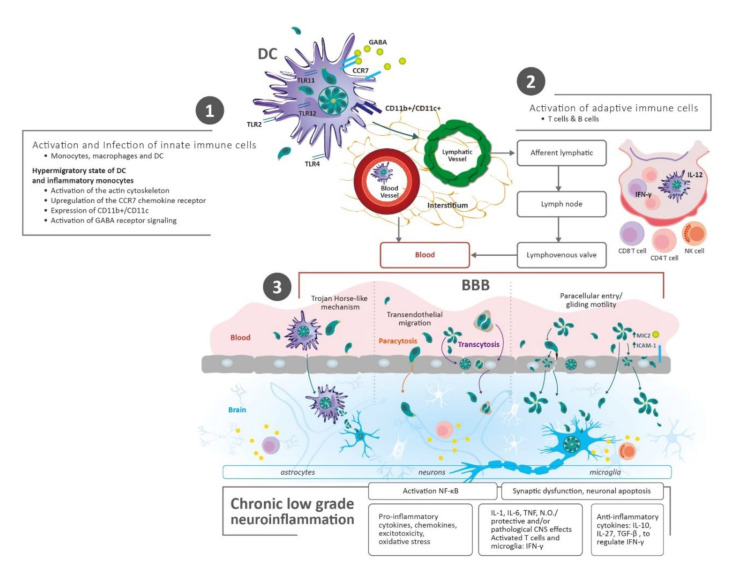Figure 1.
Parasite Transmission and Dissemination to the Brain. (1) After human infection with Toxoplasma gondii via the oral route (tissue cysts and oocysts), early immune events start in the gut tissue of the host. Innate immune cells are infected and activated, simultaneously. These cells migrate rapidly and spread hematogenously, reaching lymph nodes and peripheral tissues, such as the brain. (2) Adaptive immune cells (T and B cells) are stimulated by antigen presenting cells (i.e., dendritic cells—DC) in lymph nodes. In the same way, these inflammatory cells migrate and spread through the blood, disrupting the blood–brain barrier (BBB) and getting into the brain. (3) Mechanisms for the transfer of the parasite from the blood to the brain: I—Through infected immune cells: DC diapedesis/Trojan horse-like mechanism. Leukocytes and DC cross the BBB through the endothelial cells or via modifying tight junctions; II—Direct entry of tachyzoites/penetration of the BBB: (a) Paracytosis (through intracellular junctions), (b) Transcytosis (transportation through vesicles), (c) Paracellular entry (increase in the parasite’s microneme protein 2 (MIC2) expression/interaction with the host cell’s intercellular adhesion molecule 1 (ICAM-1), and gliding motility). Abbreviations: Blood–brain barrier (BBB); C-C chemokine receptor type 7 (CCR7); Cluster of differentiation (CD); Central Nervous System (CNS); Dendritic Cells (DC); γ-aminobutyric acid (GABA); Intercellular adhesion molecule 1 (ICAM-1); Interleukin (IL); Interferon gamma (IFN-γ); Monocyte chemoattractant protein-1 (MCP-1); Microneme protein 2 (MIC2); Natural Killer (NK); Nitric oxide (N.O); Nuclear factor kappa-light-chain-enhancer of activated B cells (NF-κB); Toll-like receptor (TLR). Transforming growth factor-beta (TGF-β); Tumor Necrosis Factor (TNF).

